|
Signal Boxes |
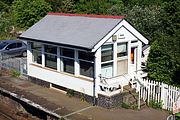 |
Acle Signal Box, pictured on 26 May 2017. This 20 lever Great Eastern Railway signal box was built in 1883, although it has been heavily modified, in particular the windows. Note the grey weather sealing that has been applied all over the roof tiles. | |
 |
The 1883 built Ascott-under-Wychwood Signal Box stands next to the station and level crossing on the edge of the village and used to mark the start of a 14 mile single track section of the Cotswold Line to Wolvercote Junction. The line was redoubled as far as Charlbury in 2011. With a storm approaching, the box is pictured in the late evening on 17 September 1983. As the box faces north it is only possible to get a good shot either very early or late in the day. |
|
 |
Ascott-under-Wychwood Signal Box, pictured on 14 May 2018. This makes an interesting comparison with the picture I took (from a slightly different angle) in 1983. The principal change over 35 years has been the replacement of the windows. |
|
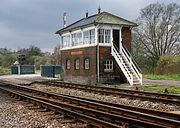 |
Although out of use since 1973, Awre signal box still survives, although the building has deteriorated considerably since this 3 April 1982 view. Apart from the missing name board, this almost has the look of an operational box. The centre section of windows has now been boarded up, and the rest smashed and covered up from the inside. The steps have long since gone. |
|
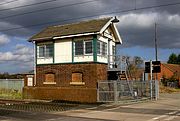 |
Bathley Lane Signal Box is situated on the East Coast Mainline on the edge of the village of North Muskham, on (as the name suggests) the minor road leading to Bathley. This 1930 built box is pictured against a stormy backdrop on 10 March 2011. Note the unfortunate modern necessity of many such buildings - vandal proof mesh on the windows. |
|
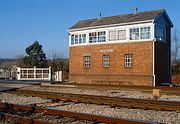 |
Bishton Crossing Signal Box pictured on 15 February 2003. The box controls the level crossing seen on the left, although there is a nearby underbridge for road traffic. However, as this has the ridiculously low headroom of 5' 6", anything other than a standard family car has to use the crossing. As the signal box is not open at night, this must cause some problems for local residents! |
|
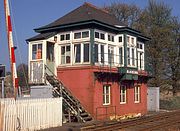 |
The 1933 built LMS Blackford Signal Box is pictured on 17 April 2003. This box formerly controlled traffic on the busy A9 road between Striling and Perth, but since a bypass was built to take traffic away from the village, the level crossing on the Highland Mainline has become considerably quieter! |
|
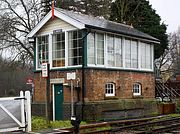 |
Blankney Signal Box, pictured on 14 December 2009. As can be seen from the station sign just behind the box, this is actually adjacent to Metheringham station. When opened in 1882 the station was called Blankney & Metheringham. Now the two local villages each give their name individually to the signal box and station! |
|
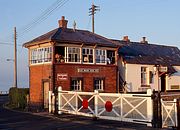 |
Blue Anchor Signal Box on the West Somerset Railway is pictured in the very last rays of the setting sun on 19 September 1998. With the sea in the background, crossing gates in the foreground and adjacent booking office adorned with vintage enamel advertising signs, this box occupies a very photogenic location, although I would imagine it is not quite so idyllic when there is a gale blowing off the sea in the winter! |
|
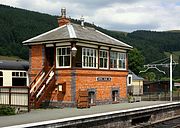 |
Looking every inch a vintage Great Western Railway signal box, Carrog is in fact a new build by the Llangollen Railway to replace the one demolished before they acquired the line. It is pictured in a few seconds worth of sunshine on an increasingly cloudy 26 June 2010. |
|
 |
Crabley Creek Signal Box, photographed on 3 December 2019. Although the semaphore signalling was abolished at this location in 2018, a covenant in the original sale document when the line was built stipulates that the level crossing to Crabley Farm must always be manned. |
|
 |
Culgaith Signal Box was built by the Midland Railway in 1908. The adjacent station closed in 1970, and the box now just controls the level crossing - one of the few on the Settle to Carlisle line. It is pictured here on 16 September 1995. |
|
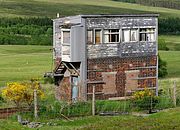 |
The long disused Dalnacardoch Signal Box was a well known landmark on the bleak section of the Highland Main Line between Pitlochry and Kingussie. In this 10 June 2007 view, the Scottish weather has obviously taken its toll on the building despite some relatively recent patching up with corrugated iron. Note that even in this remote location it was thought necessary to prevent vandalism by bricking up the locking room windows and chopping off the lower section of the access steps. The box was demolished in 2009. |
|
 |
Dalwhinnie Signal Box, pictured on 29 August 2018. This is the highest operational signal box in the UK. The box was built by the Highland Railway in 1909, but was modified a few years ago, with a full width extension replacing the original half width porch and wooden staircase. |
|
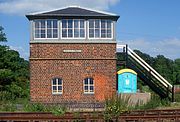 |
Dorrington Signal Box, photographed on 23 June 1996. This 1872 built box has a very characteristic rugged and basic look, a trait it shares with nearby boxes such as Marshbrook and Bromfield. The windows have been replaced since this picture was taken, and the box is now surrounded by palisade fencing, rather than the rural bushes and weeds, as seen here. |
|
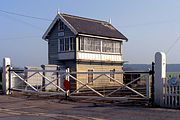 |
The Manchester, Sheffield and Lincolnshire Railway 1885 built Elsham Signal Box, pictured on 11 March 1997. The box closed in 2015, but it still survives, as it is Grade II listed. Note the standard feature seen at a number of level crossings - the car wheel trim hanging on the fence! |
|
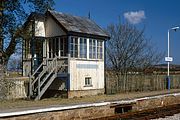 |
The disused signal box at Forsinard pictured on 20 April 2003, still virtually intact, with the exception of a missing nameboard. The building has subsequently been boarded up. This diminutive Highland Railway structure was rendered redundant with the advent of the Far North Line RETB signalling scheme in 1984. |
|
 |
There are two signal boxes at Gotherington. One operational one on the Gloucestershire Warwickshire Railway, and a nearby replica box in the garden of the privately owned Gotherington Station House. The latter is pictured on 14 January 2001. |
|
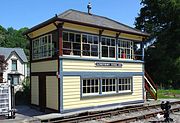 |
Glyndyfrdwy Signal Box basks in the sunshine on 26 June 2010. This 1904 built box formerly stood at Leaton on the GWR Gobowen to Shrewsbury line. It closed in 1987 and was moved to the Llangollen Railway shortly afterwards. It now controls the line's only level crossing. |
|
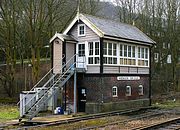 |
Hebden Bridge Signal Box was built by the Lancashire and Yorkshire Railway in 1891. The grade II listed building, which contains its original 36 lever frame (with two more recent additions) is one of the best surviving examples of a L&YR box. It is pictured here on 16 March 2015. |
|
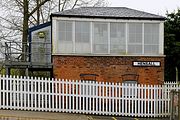 |
Grade II listed Hensall Signal Box, pictured on 18 March 2020. The box was built by the Lancashire & Yorkshire Railway in 1875. It was use, with various alterations to the lever frame, for 139 years, finally closing in May 2014. |
|
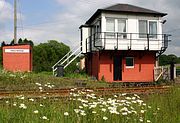 |
The Ox-eye Daises are in full bloom opposite Holywood Signal Box on 8 June 2007. This much modified Glasgow & South Western Railway design is situated just to the north of Dumfries. I'm not sure what the red painted brick colour scheme is based on, but it certainly makes the buildings show up from a distance! |
|
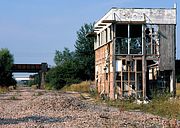 |
Honeybourne West Loop Signal Box succumbs to the elements (and the vandals) after being disused for several years, when pictured on 12 August 1984. The box had a relatively short life, having been built in 1960. Looking at the rather basic construction, it presumably wasn't intended to last very long, and is certainly nowhere near as well constructed as the typical GWR box. |
|
 |
Hubberts Bridge Signal Box, pictured on 1 September 2002. This box was built in the early 1960s, to replace one on the other side of the line, which was collapsing into the nearby Forty Foot Drain! Note the unusual design, with a huge concrete mid section, cantilevered out over the brick base. |
|
 |
Insch Signal Box was built by the Great North of Scotland Railway in 1886. The heavily modified box is pictured on 25 June 2013. The road crosses the line at an extreme angle, and the box is at the extreme end of the platform, in a very restricted position. |
|
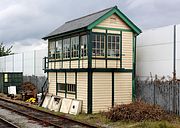 |
Leeming Bar Signal Box, pictured on 20 July 2025. The box, which replaces the demolished original box, came from North Wootton (near Kings Lynn). It was moved to the Wensleydale Railway in 2008. The box was originally much shorter than this, and in fact the lower section seen here very skillfully disguises a new concrete block base. |
|
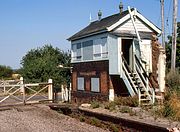 |
Derelict and boarded up, Long Marston Signal Box is pictured on 14 August 1983. Note the remnant of the station building on the right, showing how the former building butted right up to the signal box. Note also the length of rail still in the road. Strangely, the rails in the road are the only surviving part of this picture! A large industrial unit now stands where I am stood to take this picture. |
|
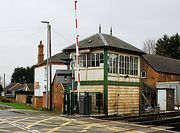 |
Lowdham Signal Box dates from 1896. It was built by the Great Northern Railway next to the level crossing and station, on the Nottingham to Newark line. It is pictured here on 11 March 2017. Definitely in need of a repaint! It won't however get one, as the box closed on 30 September 2016. |
|
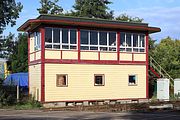 |
Lydney Junction Signal Box, pictured on 15 September 2018. The box, which stands on the opposite of Harbour Road to the Dean Forest Railway's Lydney Junction station, was originally the Heysham Harbour box, and was moved to the railway after spending over a decade out of use at its original location. 73001 can just be seen on the extreme left. |
|
 |
In a very brief burst of sunshine and with dark threatening clouds in the background, March West Junction Signal Box is pictured on 4 November 1986. This small 27 lever box controlled access for freight traffic into Whitemoor Yard from the west. It closed on 29 November 1987 and has since been removed. |
|
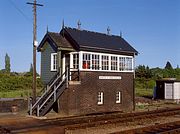 |
Although Moreton-in-Marsh Signal Box features in a number of my pictures, here is a fine close up view taken on 26 May 1986, when it still retained its original mullioned windows. In fact there are hardly any signs of the modern railway in this view, from the vintage bullhead track in the foreground to the single line token machine visible through left hand window. |
|
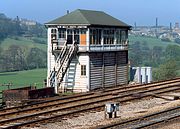 |
New Mills South Junction Signal Box, pictured on 27 April 1984. This 1903 Midland Railway box is perched on the edge of a steep embankment, and in the 1980s was still clear of surrounding vegetation, revealing a fine background of nineteenth century mill buildings. |
|
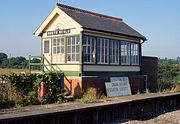 |
North Weald Signal Box, pictured on 22 July 1993. At this time the line was still operated (at peak times only) by London Underground, but the disused signal box had already been smartened up by the Ongar Railway Preservation Society, as indicated by the improvised sign. There would be no place here now for sprawling bindweed and weeds growing on the platform. As the flagship station of the Epping Ongar Railway, the whole area has been smartened up, and the double track reinstated. |
|
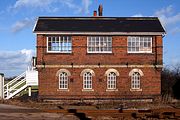 |
Oxmardyke Signal Box is situated just to the east of Gilberdyke, on the Hull line. This impressive structure was built by the North Eastern Railway in 1901, and formerly controlled the section between Gilberdyke and Broomfleet. When pictured here, on 7 February 1998, its role had been reduced to merely controlling the adjacent level crossing. |
|
 |
Pirton Signal Box survived the introduction of colour light signals on the Gloucester to Birmingham route, being retained to operate the adjacent level crossing. However, when that was replaced by remotely operated lifting barriers in the 1980s it became redundant. It is pictured here shorn of any identification and minus its lever frame on 15 June 1986. It was demolished shortly afterwards. |
|
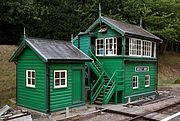 |
Rothley Signal Box, photographed on 3 September 2022. This is not the original box at this location, but was acquired by the Great Central Railway from Blind Lane, Wembley, and re-erected here in 1990. The box contains a 20 lever frame, which controls the station area, and adjacent carriage sidings. |
|
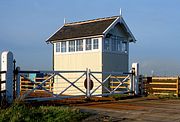 |
Roxton Sidings Signal Box, on the Barnetby to Grimsby line, was erected by the Manchester, Sheffield and Lincolnshire Railway in 1883. As well as overseeing the gates on the Immingham to Keelby minor road, it also controlled access to a single short siding, shown on the 1905 25 inch Ordnance Survey map as Immingham Siding. This was of course long before the port of Immingham with its associated maze of sidings was constructed. The box is pictured here on 8 December 2001. |
|
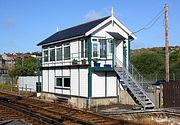 |
Ryde St John's Road Signal Box was built in 1928 by the Southern Railway. Originally only one of a number of boxes on the Isle of Wight, it now controls all the signalling on the remaining mainline route from Ryde to Shanklin. It is pictured here on the morning of 29 May 2013. |
|
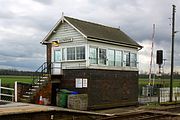 |
Saltmarshe Signal Box was constructed by the North Eastern Railway in 1905. This 19 lever box is pictured on 4 April 2015, not looking too bad after 110 years. The foot crossing directly in front of the box is also the only public access to the station's down platform. |
|
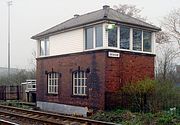 |
Seaham Signal Box, pictured on a very foggy 3 April 1999, This North Eastern Railway box was opened in 1905, and latterly was equipped with a 23 lever frame. In its final years its sole purpose was to control an adjacent foot crossing. This was replaced by an underpass, and the box was demolished in 2014. |
|
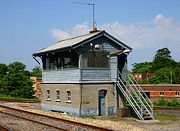 |
Sligo Signal Box, pictured on 24 May 2018. The Dublin to Sligo line is now controlled by colour light signals, but this Midland Great Western Railway box has been retained. This is a replacement for the box that was burnt down on 15 November 1922, during the Irish Civil War. |
|
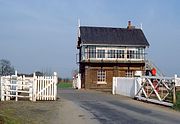 |
St James Deeping Signal Box, pictured on 21 April 1984. Why the box was named St James Deeping, when the nearby village is called Deeping St James is a mystery. The 1876 built Great Northern Railway box was removed in 2014. There was not much work for the signalman on this particular day, as the line was closed for engineering works. |
|
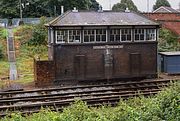 |
Sutton Bridge Junction Signal Box, on the outskirts of Shrewsbury, pictured on 2 September 2000. This Great Western Railway box controls the routes to Hereford and Aberystwyth. The points in the foreground form the facing crossover, enabling trains bound for Wales to access to the single track line. |
|
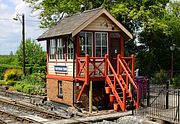 |
Tenterden Town Signal Box, on the Kent & East Sussex Railway, pictured on 2 June 2013. The K&ESR was built as a light railway, and although it had signals, there were not originally any signal boxes. This 1893 built Saxby & Farmer box came from Chilham. The fire buckets seen here were used later in the day, when GWR 0-6-2T 6619 set fire to the track! |
|
 |
The disused and boarded up Thetford Signal Box, photographed on 14 August 2021. The box was built by the Great Eastern Railway in 1883. It remained in use for 129 years, until the area was resignalled in 2012. It is Grade II listed. |
|
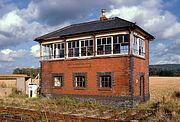 |
Although it looks in a bad way and ripe for demolition, this box happily survives and is much better condition today. This is Toddington Signal Box on the Gloucestershire Warwickshire Railway, pictured on 14 October 1979, before the society took over and just before the track was lifted. Although there are a few broken windows and the nameboard has gone, the frame can still be seen in situ and the brickwork is generally in good order. From this angle it appears that the down main line has been lifted, but in fact only one section of rail had been removed from in front of the box, all other trackwork in the station area being complete. |
|
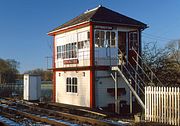 |
Being an Oxfordshire photographer, Uffington means the site of the former junction with the long closed Faringdon Branch, on the Great Western Mainline between Didcot and Swindon. However, there is anther Uffington, and while my local Uffington Signal Box disappeared along with the station in the 1960s, the Midland Railway box on the Peterborough to Stamford line still survives. With a little snow lying on the ground, it is pictured here on 30 December 2001. |
|
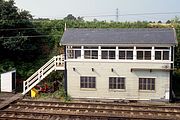 |
Welbeck Colliery Junction Signal Box pictured on 27 June 1992, complete with signalman's moped! This 48 lever box was built by the Great Central Railway in 1915. The box closed in 1997, and the line to Welbeck Colliery closed in 2010. |
|
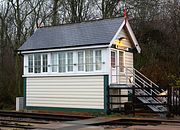 |
Wickenby Signal Box on the Market Rasen to Lincoln line, pictured on 14 December 2009. The nearby Wickenby station has closed but the box survives to operate the adjacent level crossing. Built in 1890 by the Manchester, Sheffield & Lincolnshire Railway, this box has seen considerable refurbishment in recent years, including a new roof, windows and entrance stairway. |
|
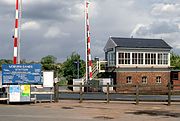 |
Woburn Sands Signal Box and the adjacent level crossing, pictured on 29 May 1988. The Bedford to Bletchley line was resignalled in 2004, losing all of its character along with the semaphore signalling. This box was demolished in August 2004. Note the Woburn Sands Station information board on the left, clearly a local handmade item. |
|
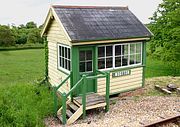 |
The diminutive Wootton Signal Box, on the Isle of Wight Steam Railway, pictured from a moving train on 29 May 2013. This little building has had an interesting history, having moved around the island quite a lot. Originally starting off at Newport, it was then used at Freshwater, before ending up at Wootton, after a period being used as a bus shelter! |